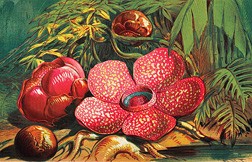If Your Cat Turns Into A Tiger, You Were Forewarned
- Share
- Tweet
- Pin
- Share
• Researchers have now sequenced the genome of the Siberian tiger and compared it to that of the house cat. It turns out that “a tiger is just a big domestic cat,” said Jong Bhak of the Genome Research Foundation in South Korea. The tiger shares 96 percent of its genes with your pet cat. So if your cat turns into a tiger, you were forewarned. (The Week, Oct. 11, 2013)
• Since lots of tiny fruit flies are showing up in Door County kitchens, fruit fly traps are selling briskly at local hardware stores. As we shoo them away from exposed fruit, we should do so with respect, for modern genetics is grounded on studies of these flies. Their scientific name is Drosophila melanogaster, and they have been more thoroughly studied than lab mice or rats. Small, cheap to raise, and with a rapid breeding cycle, they are ideal for many kinds of studies relating to humans because about 75 percent of human disease genes have a match in the fruit fly genome. Studies of fruit flies have contributed to our understanding of skin cancer, the immune system and the development of tissues. One writer referred to these flies as scientific “superstars.” From them scientists learned that there is such a thing as a “gene,” that genes are located on chromosomes, that genes can mutate, that exposure to x-rays can cause mutations, and that certain genes regulate body plan and organ development. They also learned about mutations in tumor suppressor genes and how fruit flies can serve as test organisms for cancer causing toxicants in the environment. Research on fruit flies has earned Nobel Prizes for four scientists, and these little “gnats” continue to be major research animals in laboratories all over the world. So show some respect. (Methods in Molecular Biology, vol 420, pp. 1-25, 2008; speakingofresearch.com/2012/drosophila; other sources)
• Recently scientists discovered that the Alpine swift (Tachymarptis melba), which is about the size of a barn swallow, migrates from Europe to western Africa nonstop during a six-month period, crossing the Sahara Desert along the way. Before the swifts left Switzerland on their migration to Africa, several of them were outfitted with tiny postage stamp size transmitters that tracked the birds’ activity day and night and provided information on their longitude and latitude. The birds fed aloft by snatching flying insects. The transmitted data revealed that the birds flew nonstop for 1,240 miles and never stopped to roost. At night the swifts often leveled off and slowed their wing-beats, as if they were gliding. To the researchers this diminished activity suggested that the swifts might be dozing off. This kind of awake/sleep remains a mystery, although some mammals (e.g., dolphins) achieve it by shutting down half their brain. (Liechti et al, 2013, Nature Communications, Oct. 8 issue; latimes.com/science/sciencenow, Oct. 8, 2013)

The Rafflesia-arnoldii, an Indonesian plant that has the largest and smelliest flower in the world. From the 1886 book “Nature and Art, Vol. 1.” (Public domain)
• The two largest flowers in the world are both found in the mountains of Sumatra. Rafflesia arnoldi grows close to the ground and produces a flower about three feet in diameter weighing about 25 pounds. The other giant flower is produced by Amorphophallus titanium, or titan arum, which may produce a nine-foot tall flower. A few botanical gardens have cultivated these plants, although it takes about six years to grow from seed to flower. Thereafter it may take months or even years for it to flower again. Both of these large flowers have one thing in common: they stink to high heaven and have been called “corpse flowers.” (kew.org/plants-fungi; other sources)

